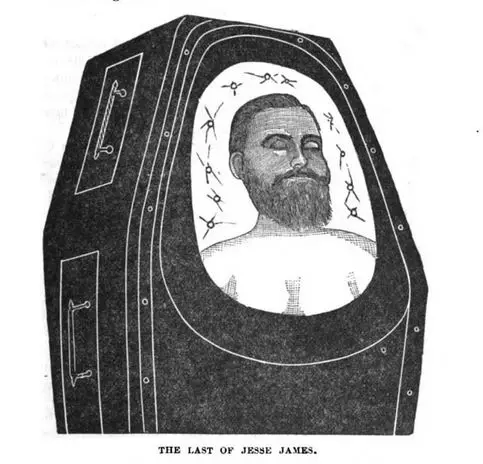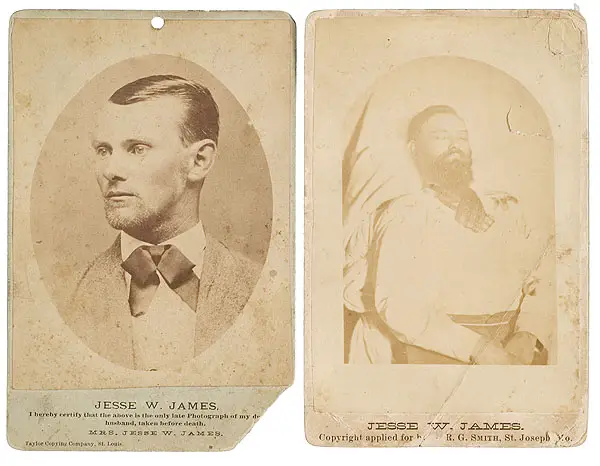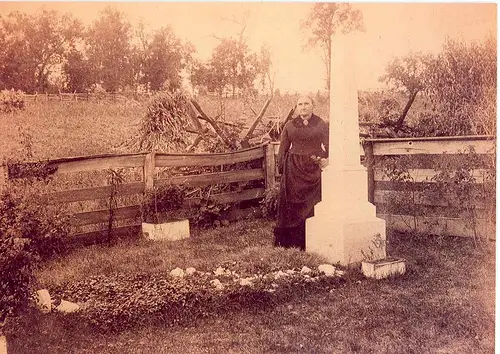After Jesse James was killed by Robert Ford on April 3, 1882, a funeral service was held for the outlaw at the First Baptist Church in Kearney, Missouri on April 6, 1882.
Jame’s body had been brought from the Sidenfaden Funeral Parlor in St. Joseph to Kearney, Missouri in a metal casket, which had a small glass window so the body could be viewed, on a train provided by the Hannibal and St. Joseph railway.
A historic ledger kept by the Sidenfaden’s Funeral Parlor indicates that the cost of James’ casket and shroud was $250, which was ten times what they would normally cost at the time, possibly due to James’ celebrity status or perhaps because the coffin was made of metal and glass rather than wood.

When the body arrived in Kearney at 2.43am it was carried to the Kearney Hotel across from the train depot and put on public display for several hours.
Hundreds of people reportedly viewed the body that morning. The various attendees who actually knew James confirmed that the body was that of Jesse James while others compared photographs of Jesse James to that of the body and also agreed it was James.
At around 2pm that afternoon, the body was placed in a wagon and the funeral procession left the hotel and headed for the First Baptist Church, where Jesse was converted in 1866. The church was reportedly packed, with standing room only remaining.
The pallbearers were J.D. Ford, J.T. Reed, Charles Scott, James Henderson, William Bond and a six pallbearer whose true identity remains unknown but who was identified at the time as James Vaughn.
Seated beside the coffin were Jesse’s family: his mother Zerelda Samuel, his wife Zee James and their two children, as well as Mr. and Mrs. Luther James, Fannie Quantrill Hall and Mary Mimms. Frank James was not present at the funeral, since he was still on the run from the law.
The funeral began with the singing of the hymn “What a friend we have in Jesus” before Reverend R.H. Jones read a passage from the Book of Job which ended with the sentence “Man born of woman is of few days and is full of trouble.”
Jones read the 39th Psalm and offered a prayer for Jesse’s mother, wife and children asking that their bereavement lead them to a true knowledge of God.
The funeral sermon was delivered by Reverend J.M.P. Martin. Martin didn’t mention Jesse James by name during the funeral nor did he discuss his life or deeds and instead chose to appeal to his family and friends to accept God.

At the end of the service, Martin requested that only the family members accompany the body to the burial site but no one obeyed this request and nearly 50 or 60 people in buggies, wagons and on horseback, followed the casket back to the Samuel farm where James’ coffin was taken into a bedroom where his brother John Samuel, lay in bed wounded.
John Samuel was helped up in bed and upon seeing his brother’s face, cried and said “Oh, Oh, God! Oh, Jesse! That ever I should see you brought home this way!” according to a news report in the St. Louis Globe-Democrat.
Zerelda approached the bed, raised her hand and said “Johnny, my boy, look upon your sainted brother Jesse, your murdered brother Jesse. Look upon him, and then look upon your poor broken-hearted, shattered mother. He is dead. They have killed him, your poor brother Jesse. He is in heaven. He has gone to God, and God will judge him. He is taken from me, and I have no one now to lean upon. Johnny, live for your mother – your poor, heartbroken mother.”
The coffin was then carried outside and placed on some chairs in the yard. Zerelda approached the coffin and said “My heart is broken, my heart is broken, broken, broken. Oh, my heart is broken. They have killed my sainted son.”
Zee James approached the coffin after Zerelda, sobbing and called on God to avenge Jesse, who she said was killed cowardly for money.
Jesse James was then buried in a grave in the front yard of the farm so his mother could watch over the grave and prevent grave robbers from disturbing his body.
Inscribed on James’ tombstone were the words:
“Jesse W. James, Died April 3, 1882, Aged 34 years, 6 months, 28 days, Murdered by a traitor and a coward whose name is not worthy to appear here.”
A few months later, in June of 1882, Baptist minister Revered William Harris of St. Joseph, Missouri spoke at a Baptist Minister’s Conference during which he mentioned James funeral and stated that the press had been reporting lately that the Baptist church condoned Jesse James’s bad deeds by holding a funeral for him, a charge Harris vehemently denied and explained that the church merely provided a funeral for James out of respect for his grieving mother.

The speech was later published in the Daily Picayune in New Orleans on June 11, and Harris was quoted as saying:
“The condemnation of the Ford boys for the manner in which they killed Jesse James has been wrongfully construed into an approval of the bandit. It has gone forth that Jesse James was a member of the Baptist Church at the time of his death, that the Baptists of Missouri regret his death, that many of them were at his funeral, and that a Baptist minister delivered a funeral oration eulogizing the dead robber. Jesse James was not a member of any Baptist church, Baptists did not weep at his funeral, and a Baptist minister did not eulogize him…”
Harris went on to explain that he had declined the offer to officiate the funeral himself and stated “I declare that no people in this Union hold Jesse James in greater detestation than the Baptists of Missouri.”
Second Funeral:
After Jesse James’ wife, Zee, died in 1900, she was buried in the James family plot in Mount Olivet Cemetery. Meanwhile, Jesse’s mother, Zerelda, had moved away from the family farm and couldn’t keep an eye on his grave anymore so the decision was made to move James’ body and bury him in the family plot next to Zee.
On June 29, 1902, Jesse James’ body was dug up and reburied in the James family plot at Mount Olivet Cemetery in Kearney.
The original coffin had deteriorated so badly that it broke apart when it was lifted out of the ground and James was reburied that afternoon in a new coffin.
Press reports at the time state James was reburied in a black and/or a metal coffin but it was later discovered, when the body was exhumed in 1995, that the coffin was actually a cheap pine box with silver-plated handles.
A funeral was held for the reburial and six members of Quantrill’s Raiders served as pallbearers. No prayers were read and James was buried in silence in the presence of a small crowd, which included his mother, Zerelda Samuels, his brother Frank James and his son Jesse James Jr.
Third Funeral:
On July 17, 1995, due to repeated claims that Jesse James faked his death, James’ body was exhumed from Mount Olivet Cemetery for DNA testing. When James’ body was dug up, it was discovered that the coffin had deteriorated and the body was badly decomposed due to being exposed to the elements.
After the DNA tests were completed, a funeral was held on Saturday, October 28, at the Knights of Columbus Community Center before the body was reburied in Mount Olivet Cemetery.
Over 600 people attended the funeral, which was organized by Robert L. Hawkins III a commander of the Sons of Confederate Veterans. Attendees included James’ six great-grandchildren and over a dozen people dressed in Confederate uniforms who took turns standing honor guard over the casket.
Two groups of pallbearers, one made up of eight historians, and the other by eight descendants of Confederate soldiers, helped carry the casket into and out of the hall.
The remains were placed in a cardboard box which was lined with styrofoam. The cardboard box was then placed in a coffin made of poplar wood which was draped with six Confederate flags.
The hymn, “What a Friend We Have in Jesus” was sung at the funeral, as it was at James’ first funeral in 1882. After the funeral was over, two horses pulled the glass-enclosed white hearse to the Mount Olivet Cemetery where members of a Confederate Civil War re-enactment group fired a seven-gun salute with 1853 black-powder rifles.
The funeral was originally scheduled to be held at a Baptist church but the church declined to host it, fearing it would become a media circus.
Then it was scheduled to be held at William Jewell College, a Baptist school in Liberty that James’ father helped found, but the college changed their minds nine days before the funeral because they objected to the group’s plans to use Confederate flags in the ceremony.
It was then that the Knights of Columbus Community Center offered to hold the service in its hall.
The results from the DNA test were released a few months later, in February, and it was determined that the body was that of Jesse James.
If you want to read more about Jesse James, check out the following article on the best books on Jesse James.
Sources:
Triplett, Frank. Jesse James: The Life, Times, and Treacherous Death of the Most Infamous Outlaw of All Time. Skyhorse Publishing, 2013.
Settle, William. Jesse James Was His Name. University of Missouri Press, 1966.
Steele, Philip W. The Many Faces of Jesse James. Pelican Publishing Company, 1995.
Brooks, Rebecca Beatrice. “Jesse James Timeline.” Civil War Saga, 4 September, 2020, civilwarsaga.com/jesse-james-timeline/
Bell, Kim. “The Outlaw Jesse James Reburied (We Think).” St. Louis Dispatch, 29 Oct. 1995, stltoday.com/the-outlaw-jesse-james-reburied-we-think/article_732612be-07eb-11e2-912b-001a4bcf6878.html
“Jesse James Grave to be Exhumed.” Chicago Tribune, 13 July. 1995, chicagotribune.com/news/ct-xpm-1995-07-13-9507130381-story.html
“Jesse James Reburied.” The Houston Post, 2 July. 1902, newspapers.com/clip/3383422/jesse-james-reburied-july-1902/
“Remains Reburied as Jesse James.” UPI, 30 Oct. 1995, upi.com/Archives/1995/10/30/Remains-reburied-as-Jesse-James/6377815029200/
“Great Detail on the Jesse James Funeral & Family Particulars.” Timothy Hughes Rare and Early Newspapers, rarenewspapers.com/view/631660
“Jesse James: Baptists Did Not Weep at His Funeral.” The Pathway, 30 July. 2020, mbcpathway.com/2020/07/30/jesse-james-baptists-did-not-weep-at-his-funeral/
“Dust to Dust: The Last Act Performed in the Jesse James Tragedy.” St. Louis Globe-Democrat, 6 April. 1882, rarenewspapers.com/view/631660

my grandmother, and her family knew him well!
My family . Actually Harietter O. SIDENFAIDEN were the funeral home to carry his body the first time and Embalm him. Its great to read a piece of history your family was involved in.